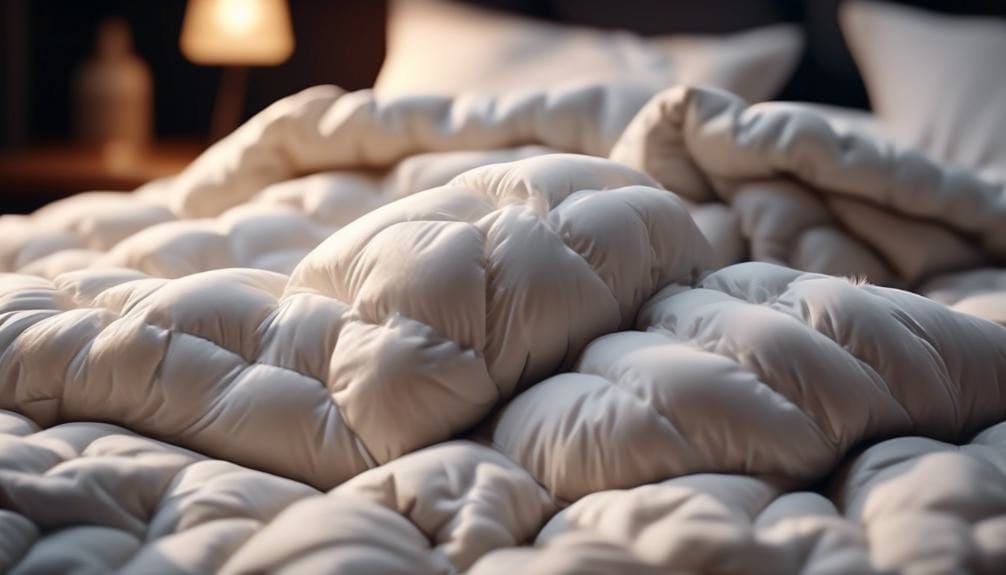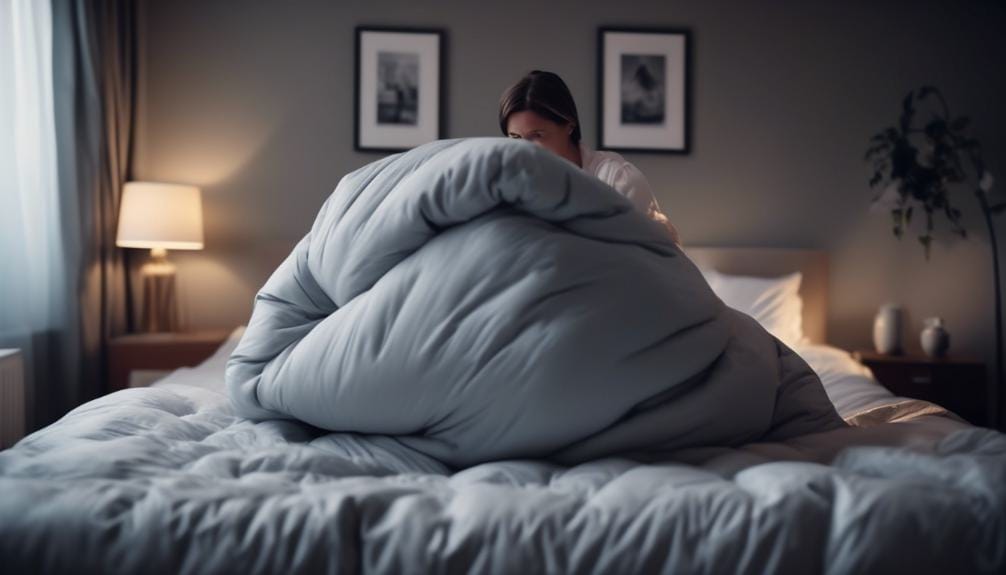Why Is My Duvet So Heavy? Investigating Weight Issues
Have you ever wondered why your duvet feels so heavy? Your cozy sanctuary shouldn’t be a struggle to lift, and understanding the factors behind its weight can make a world of difference.
Let’s uncover the secrets behind the heaviness of your duvet and explore how its construction and fill power play a crucial role in determining its weight.
Key Takeaways
- The fill material, whether down, feathers, or synthetic fibers, plays a significant role in determining the overall weight of a duvet.
- Fill power, which measures the loftiness of the down, impacts the weight as higher fill power often results in a lighter duvet.
- The size and dimensions of the duvet also affect its weight, with larger duvets naturally being heavier.
- Additional features such as extra layers, quilting, or specialized treatments can add to the weight of a duvet.
Common Materials Used in Duvets

What are the common materials used in duvets and how do they differ in terms of fill and construction?
When it comes to duvets, the fill material plays a crucial role in determining its characteristics. Down, derived from geese or ducks, is a popular natural fill, offering exceptional warmth and breathability.
On the other hand, down alternatives, typically made from treated polyester blends, provide a hypoallergenic option. The construction and thread count of the duvet cover are also essential considerations for durability and comfort.
Additionally, factors such as fill power, fill weight, and duvet size contribute to the overall feel and performance of the duvet. Whether it’s for temperature regulation, a preference for weighted blankets, or simply a desire for coziness, understanding the nuances of fill materials is pivotal in choosing the ideal duvet for your needs.
Factors Affecting Duvet Weight

The weight of a duvet is influenced by various factors, including the fill material, fill power, size, construction, and additional features.
The fill material, be it down, feathers, or synthetic fibers, plays a significant role in determining the overall weight of the duvet.
Additionally, the fill power, which measures the loftiness of the down, impacts the weight as higher fill power often results in a lighter duvet.
The size and dimensions of the duvet also affect its weight, with larger duvets naturally being heavier.
Furthermore, the construction and design, including stitching and casing, can influence the overall weight.
Additional features such as extra layers, quilting, or specialized treatments can add to the duvet weight.
Consider these factors when selecting the right duvet, especially when choosing a winter duvet, super king size, or a Hungarian Goose Down Duvet.
Understanding Duvet Construction

When selecting a duvet, consider the fill power, fill weight, and type of down or alternative fill used, as these factors determine the construction and overall performance of the bedding. The construction of a duvet significantly impacts its weight, warmth, and breathability. Higher fill power and weight can result in a heavier but warmer and more insulating duvet, whereas lower fill power and weight may be suitable for warmer climates or personal preferences. The type of down, such as goose or duck down, also influences the construction and performance of the duvet. To help you choose the best duvet for your needs, consider the following factors:
| Fill Power | Fill Weight | Type of Fill |
|---|---|---|
| Higher fill power results in a fluffier and more insulating duvet | More fill weight adds to the overall heaviness of the duvet | The type of fill, whether down or alternative, affects the construction and performance of the duvet |
Understanding the construction of a duvet is crucial in ensuring that the duvet you choose meets your specific needs and preferences.
Impact of Filling on Duvet Weight

Selecting the right filling for your duvet is crucial in determining its weight and overall performance. When considering the impact of filling on duvet weight, it’s essential to understand that fill power affects the loft and insulating properties, not the weight of the duvet. Here’s what you need to know about the impact of filling on duvet weight:
- Higher fill power doesn’t necessarily make the duvet heavier.
- Higher fill power doesn’t necessarily mean higher fill weight.
- Down fill weight refers to the amount of down used in a duvet, measured in ounces or grams.
- Fill weight determines the softness or firmness of a duvet, not necessarily its warmth.
- Consider seasonal needs when choosing a filling, as different fillings are better suited for summer and winter.
Tips for Managing Heavy Duvets

To effectively manage heavy duvets, consider utilizing a duvet cover with corner ties to secure the duvet in place. This will prevent the duvet from shifting and bunching inside its cover, providing a more comfortable and secure sleeping experience. Additionally, investing in a duvet with baffle box construction can help evenly distribute the weight of the filling, reducing any concentrated heaviness. Opt for a lightweight and breathable cotton percale cover to minimize the feeling of weight without compromising on comfort. Using duvet clips or fasteners can also prevent the duvet from sliding around inside its cover, keeping it in place throughout the night. Lastly, choosing a duvet with a lower tog rating can reduce the overall weight while still providing warmth.
| Tips for Managing Heavy Duvets |
|---|
| Utilize duvet cover with corner ties |
| Invest in duvet with baffle box construction |
| Opt for lightweight and breathable cover |
| Use duvet clips or fasteners |
| Choose duvet with lower tog rating |
Frequently Asked Questions
What Makes a Duvet Feel Heavy?
Higher fill power and fill weight are the key factors that make a duvet feel heavy. More down and a higher fill power result in a denser, more insulating duvet, providing a heavier feel but also greater warmth.
What Is the Lightest Weight Duvet Filling?
Mulberry silk and Tencel are among the lightest duvet fillings. Mulberry silk is breathable, hypoallergenic, and luxurious, while Tencel is eco-friendly and known for its moisture-wicking properties. Both options offer lightweight comfort.
What Weight Is a Heavy Duvet?
A heavy duvet typically weighs between 10-15 pounds, providing extra warmth and comfort. Consider factors like fill weight and size when choosing a duvet. Higher fill weight and larger sizes contribute to the heaviness.
What Makes a Comforter Heavy?
A comforter becomes heavy due to the fill weight, which determines its softness or firmness. Quality down with higher fill power also adds to the weight, providing better insulation. Personal preferences and climate influence the ideal fill weight.
Conclusion
Now that you understand the factors that contribute to the weight of your duvet, you can make informed decisions when purchasing a new one.
Consider the fill power, fill weight, and construction of the duvet to find one that meets your insulation needs without feeling too heavy.
With this knowledge, you can now better manage the weight of your duvet and enjoy a comfortable night’s sleep.
